Human advancement has always been tied to humanity’s harnessing of energy. From the harnessing of fire and inventing the plow to harnessing steam power and breaking the atom, human societies have advanced based on using the most affordable and reliable energy sources.
Modern industrialized societies have not only begun to demand this energy on command but also require it to operate everything from transportation and refrigeration to air conditioning and the Internet. Therefore, it behooves policymakers to understand the technological changes that make up the foundation of industrialized societies. Additionally, policymakers must explore how affordable and reliable energy access allowed now-industrialized economies to transition from subsistence farming to societies with a superabundance of resources.
Whether it is using steam turbines to spin electromagnets for generating electricity or using internal combustion engines to provide mechanical energy for rapid transportation, these machines have turned the chemical potential of an energy source into an engine of economic growth. Therefore, this Heritage Foundation Special Report explains how these technological advances have shaped modern industrialized societies. Additionally, it tracks how advanced economies have harnessed this energy to diminish poverty, increase agricultural productivity, decrease child mortality, and allow the populaces of industrialized societies to generate the wealth needed to address pollution concerns.
Finally, this Special Report proposes that policymakers inform both the public and international institutions about the necessity of expanding energy access. A lack of affordable and reliable energy is associated with a lack of access to clean water, adequate medical care, affordable transportation, and economic opportunities, all of which stall human advancement, especially in the most vulnerable countries. Energy, in all its diverse forms, should be harnessed by all societies—because high-income societies are also high-energy societies.
How the Development of Energy Has Enabled Humans to Flourish
After the completion of a breathtaking skyscraper, it is easy to focus on initial aspects, such as its height and grandeur. However, the most important—and often overlooked—component is its foundation. The aim of this Special Report is to reveal how energy is the true foundation of modern prosperity and an integral part of human advancement. As historian Vaclav Smil writes, “Energy is the only universal currency: one of its many forms must be transformed to get anything done.”REF
When considering metrics of human progress and prosperity, people often think of the superficial aspects of wealth, but much less often of energy. Many tend to think of human advancement in terms of dollars and cents, as well as paper currency or gold bars tucked away in a vault. This lack of understanding tends to bury the story. True economic wealth is made with the knowledge and tools that people have acquired through thousands of years of innovation—the tools that allow people to produce material products and to have free individual time.
Every building, piece of factory equipment, truck, airplane, down to the simplest of hammers represents these tools of production. What animates all these tools and devices is energy. Without energy, these engines of prosperity would fall dormant, and industrialized societies would be thrust back, as they were for thousands of years, into back-breaking subsistence work. Though many things must come together to allow prosperity, the story of human advancement is very much the story of energy.
For almost all of human history, the overwhelming majority of people lived as subsistence farmers, never traveling more than several miles from where they were born and having little time to pursue other interests. Limited by only animal and human strength, the means to produce is exceptionally limited, and with it, people’s time and focus are fixed on the demands of that subsistence work.
It is through technological advances that people have been able to unlock and harness other forms of energy, from coal to oil to the sun itself. Those in industrialized societies are fortunate to live with machines that can perform an entire person’s lifetime of work from a century ago in mere hours. These innovations have freed humanity to pursue other interests and ambitions—allowing humanity to progress with technology as well as material wealth.
This report focuses on filling in the details of the key importance of energy innovations to modern life. It also explores an empirical analysis of the myriad of ways that energy continues to benefit societal development. First, however, this report discusses, at a mechanical level, why these energy-related innovations are invaluable to the goal of building a modern civilization. Though countless examples exist that illustrate the full story of innovations and discoveries, this Special Report presents three key milestones and their direct effects: the steam engine, electricity, and the internal combustion engine.
The Steam Engine. In modern societies, carrying bags of groceries upstairs or biking uphill are common instances when people encounter gravity. However, people in earlier (and today’s undeveloped) societies often had (and still have) to contend with gravity in much more difficult circumstances, especially in mining. Before the advent of the steam engine, human or animal power was required to pull an often-complicated set of ropes and pullies to hoist heavy objects. Extracting heavy ore often necessitated animal-powered or human-powered carts to be brought outside often-unstable mines prone to being inundated with water.
Not only is water heavy, but it is cumbersome to collect and transport. As a result, flooding has posed a tremendous problem for mining operations for millennia and kept mining income per capita very low for most of history. The steam engine solved this problem. With the first commercial steam engine in 1698 from Thomas Savery, miners finally had the mechanical strength to drain water from mines and easily lift ore to send it along its way for processing.REF Additionally, the fuel for this steam engine, coal, was also the material being extracted, allowing unprecedented rates of adoption.
No amount of animal and human power could ever have accomplished what steam-powered pumps and mining equipment are able to do. Mining tools were made vastly more useful because of people’s newfound ability to harness vast amounts of mechanical energy in a concentrated form.
With the ore above ground, another problem arose, namely, how to transport it where it needed to go.
As late as 1870, nearly half of industrial power sources in America were still dependent on site-specific water wheels and not on portable, steam engines.REF Though steam engines did fundamentally transform industrial processes and allow the production of new goods, the steam engine’s most important early contribution was the revolution in bulk transportation.
Part of the efficiency of a factory is the idea of being able to bring workers, raw materials, and tools together to a single location to work together to churn out large volumes of goods. The concept has been around for a long time. Perhaps the world’s first true industrial complex was at Barbegal in southern France, built in the second century A.D.REF It took another 1,600 years for the factory model to become ubiquitous due to transportation. This ancient site in Roman France was one of only a handful of locations to which sufficient raw materials could be easily transported and finished goods could be easily transported out to markets.
When limited to pushing carts with human or animal power, transportation methods were a bottleneck in the advantageous use of industrial efficiency. As an example, in 1800 A.D. people could travel from New York City to Baltimore in only three days by horse. By 1930, people could travel from New York City to anywhere in the continental U.S. in only three days using railroads.REF This transformation opened up vast possibilities for bringing together raw materials, equipment, and workers and for being able to bring finished goods to far-flung markets. The steam locomotive and steam ships also expanded industrialized societies’ capacity to transport goods and people. In so doing, these critical energy technologies made possible the growth in per capita incomes and production that has been seen since the start of the Industrial Revolution.
Without these technologies, the development of cities and industrial complexes would simply not have been possible. The use of dense energy sources, such as coal, was essential to powering these modes of transportation. These innovations made it possible, for the first time in human history, to quickly and easily move such large masses over long distances. People could now leave subsistence farms and produce higher value per capita by specializing in productive enterprises.
The benefits did not stop there. Steam engines allowed vast amounts of power to be utilized in a concentrated fashion to forge materials and products that had been out of reach just a generation earlier, allowing the development of complex service sectors as well. For example, running water required most societies to build aqueducts to take advantage of water sources that were already at substantially higher elevation than the city they were bringing water to. Even then, this was mostly limited to bringing water to collection points, such as the fountains of the ancient city of Rome. Bringing clean water seamlessly to treatment plants and then to individual homes and businesses requires mechanical power.
The 1870 U.S. Census showed that, on average, industrial-use steam engines generated a little over 30 horsepower (hp) per machine,REF whereas today a Boeing 747 is capable of generating nearly 60,000 hp. Strapping that many horses to a plane or cramming them inside a packed factory is a disquieting thought experiment. However, these thought experiments highlight another crucial aspect of energy-related innovations—the importance of density and flexibility.
The use of modern engines and fuels—steam turbines, internal combustion engines, coal, oil, and natural gas—allows people to take advantage of energy density. Through this lightweight, concentrated, and flexible use of energy, people can create the material abundance of the modern world. This brings this report to the second milestone—electricity.
Electricity. In essence, electricity does for energy what currency does for economic value. Instead of having to maintain a large and cumbersome engine in a factory, electricity allows people to take full advantage of economies of scale to generate immense amounts of electricity within power plants and then make that energy available anywhere. This ability to split up the production of energy from the use of energy allowed for all the nuanced ways through which people have been able to integrate mechanical energy into their everyday lives. According to the Richmond Federal Reserve, “Substituting electric lights for kerosene lamps boosted nighttime illumination and reduced smoke inhalation, improving overall health. Washing machines saved hours of housework—hours that could be reallocated to other tasks.”REF
The power of combining steam power, electricity, and other energy technologies can be seen in the breathtaking transformation of American life over just around two generations. “In 1890, 25 percent of American households had running water and 8 percent had electricity. In 1950, 83 percent had running water and 94 percent had electricity.”REF
However, electricity is not an energy source itself. Electricity is a conveyance tool for energy in the same sense that a dollar is not an item for purchase. A dollar is simply a way to record the work done for someone else and a medium of exchange to transfer that value to a good or service provider.
As revolutionary as electricity was, the equipment required to use an energy source, to this day, can be very large and heavy. While electricity proved to be immediately transformative for factories and residential buildings, it would take a third development to provide the transportation revolution for industrial societies to advance human flourishing today—the internal combustion engine.
The Internal Combustion Engine. The ability to harness a vast array of petroleum products in lightweight engines allowed humans to create cars, airplanes, and the modern world of abundance. In the case of the steam engine as well as machinery that uses electricity, the energy source is used indirectly. First, the energy is collected or unleashed, such as by burning coal or storing an electric charge from a solar panel. Then that energy is transferred to one or more intermediate conveyors. For example, steam conveys the energy from coal to a turbine to generate electricity (another conveyor) and then the electricity takes that energy along to the computer screen that the reader of the report is using right now.
However, with an internal combustion engine, there is no intermediary. Once released from the energy source, the stored chemical energy is transformed into thermal energy, which goes straight to work generating the mechanical process desired. The efficiency from cutting out the middleman is what allows the efficient, lightweight, and compact design of the internal combustion engines that gave rise to cars, early airplanes, and even the jet engines that power modern aircraft.
Whereas steam-powered trains and ships could move vast amounts of goods or large numbers of people from area to area, cars and planes allowed something of a last-mile transportation network—allowing the movement of people and products from point to point. While industrializing societies first made use of trains and ships, the limits of such transportation modes to certain canals and railroads reduced their effect in areas distant from the nexus of bulk transportation. Airplanes, as well as cars and trucks, allow the diffusion of such material goods from such nexuses. Additionally, automobiles allow individuals to move from place to place affordably and reliably, thereby maximizing human utility and advancement.
Building on the Three Foundational Innovations
From these three core innovations—the steam engine, electricity, and the internal combustion engine—stem all the machinery of modern economic production. Many advances in modern economies rest on the foundation of these inventions and human ability to collect and harness energy. With reliable, vast, and affordable energy sources and continued innovations in how to utilize them, humans can continue the advancement begun in the industrial period. Chart 1 shows the penetration of many innovations in today’s society, often taken for granted.
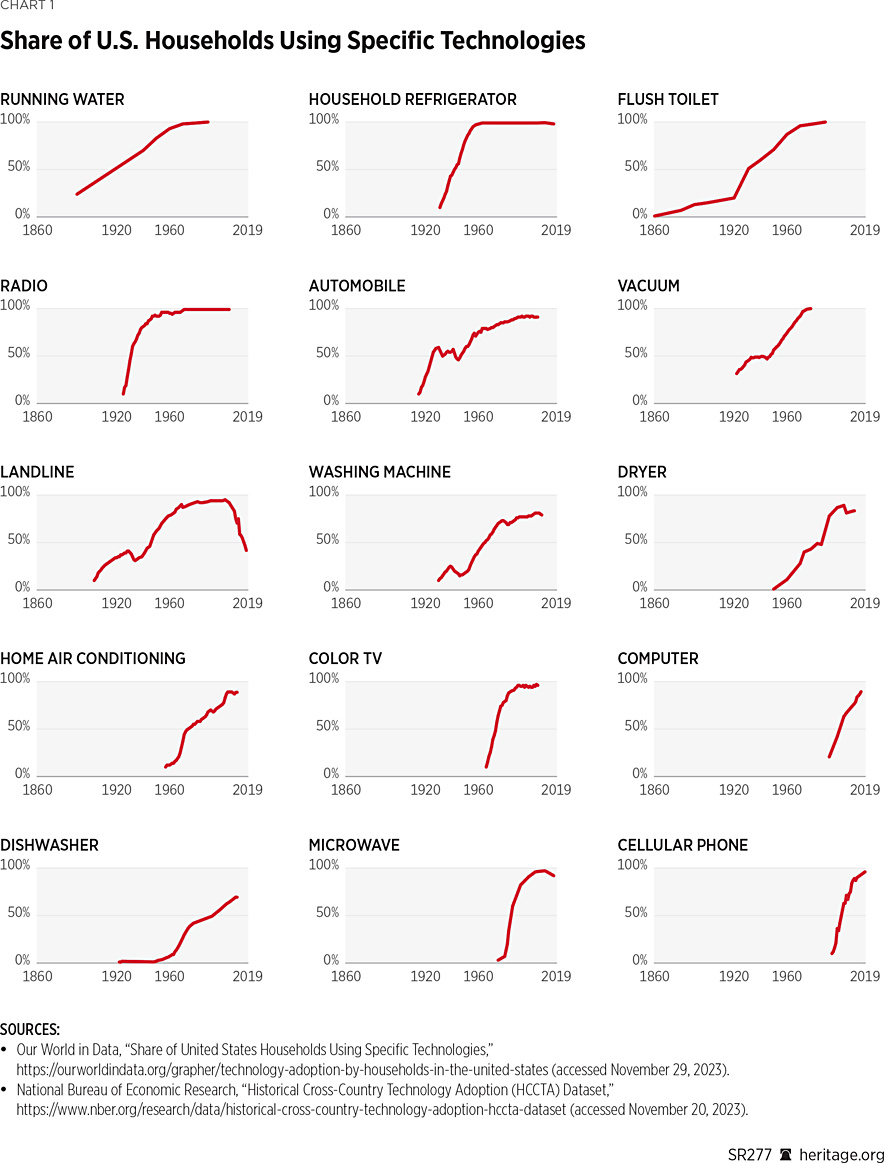
Chart 1 illustrates the proliferation of many technologies over the years that are now considered commonplace in America. These technologies include running water, household refrigerators, dishwashers, radios, automobiles, vacuum cleaners, computers, and many other inventions whose production of and use depend on access to affordable and reliable energy. Newer technologies may supplant older technologies; for example, as Chart 1 demonstrates, landline phones have declined in utilization due to the proliferation of cell phone usage over the past two decades.
Developments in and improvements to the utilization of energy have essentially molded the modern world. However, the more detached daily lives have become from these machines, the easier it is to take it all for granted and to lose sight of the energy technology at the foundations of our modern way of life. This first chapter of the story of energy leading to human advancement has highlighted the tangible and mechanical nature of energy and how it has built the modern world. The remainder of this report will go through various empirical metrics showing the connection between energy and human progress.
Energy and Well-Being: The Trends That the Data Show Over Time. Throughout the world, access to energy, prosperity, and human well-being have been intricately linked. Energy is an intermediate input into nearly every good and service, so less expensive energy brings down costs across the economy. Affordable and plentiful energy enables firms to produce more goods and services with the same input of capital and labor.
Not surprisingly, energy consumption has risen substantially over time both in the United States and globally, as depicted in Charts 2 and 3. Charts 2 and 3 also show how per capita energy consumption has evolved both in the United States as well and across the world since 1900.REF
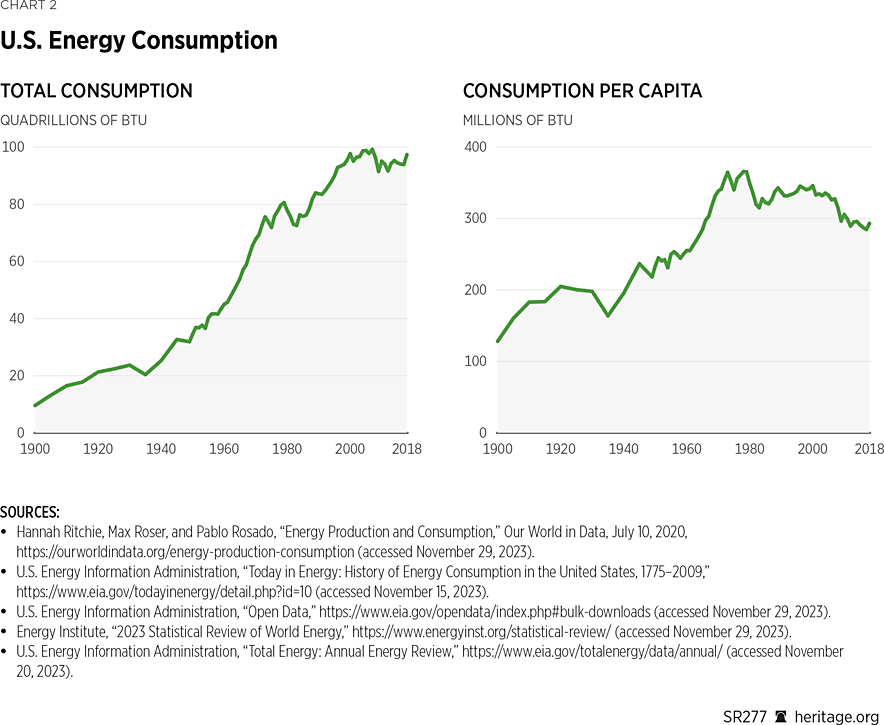
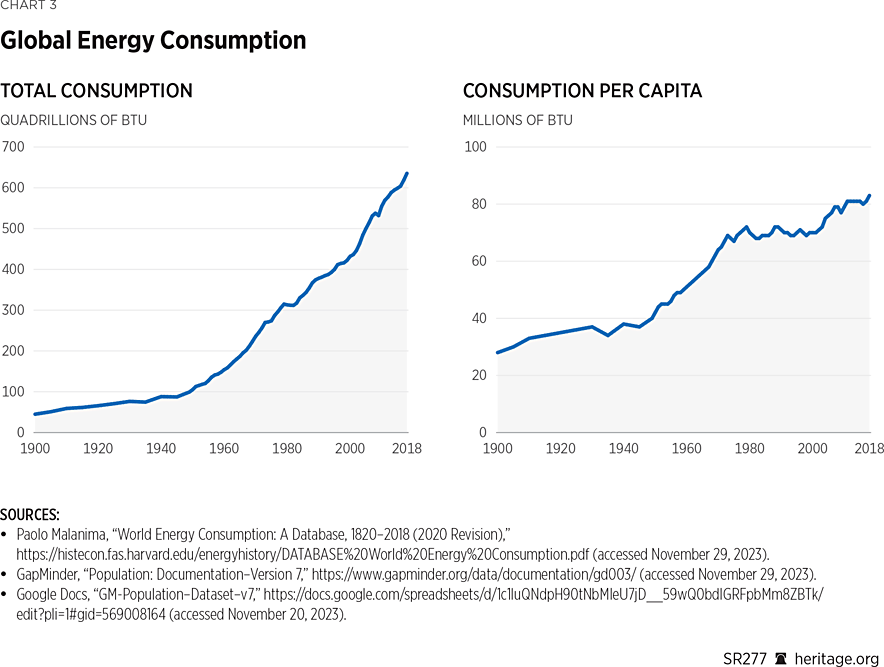
Charts 2 and 3 illustrate the significant increases in domestic and global energy consumption. In 1900, America consumed 9.6 quadrillion British thermal units (BTUs) of energy, amounting to 128 million BTUs per capita. Since then, these levels have risen substantially, increasing to 94.8 quadrillion BTUs nationwide (281 million BTUs per capita). Chart 2 also notes a slight decline in per capita energy usage since the mid-1970s due to the price increases in oil caused by the Organization of the Petroleum Exporting Countries (OPEC) oil embargo. Additionally, the Environmental Protection Agency (EPA) was established in 1970 during the Nixon Administration. By way of heavy regulation, the EPA achieved—on paper—efficiency gains by tying the hands of the automotive industry, removing certain vehicles from production and adding to the production costs of other vehicles. This regulatory approach, at the expense of economic growth, reduced the trend of energy usage in the United States.
Worldwide energy consumption has also shown similar increases since 1900: 44.96 quadrillion BTUs of energy were consumed globally in 1900 (28 million BTUs per capita). This number increased more than 13-fold by 2018 to 635 quadrillion BTUs (83 million BTUs per capita).
Regardless, as energy consumption has increased worldwide, so have many other aspects of societal progress, including gross domestic product (GDP), agricultural yield, and health indicators among others. Chart 4, for example, shows increases in global per capita GDP over time.
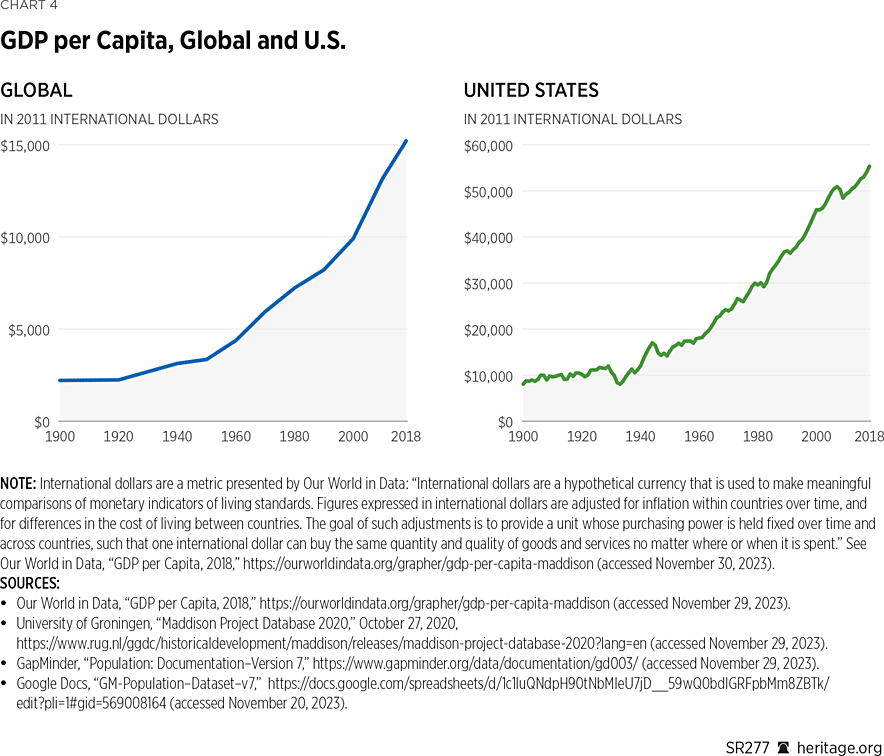
Chart 4 shows the vast increases in income that have accompanied expanded access to, and greater use of, energy. From 1900 to 2018, real global per capita income increased from $2,200 to $15,000 (in international 2011 dollars), an increase of more than 600 percent. During this same period, per capita income in the United States increased from $8,000 to $55,000 (in international 2011 dollars).REF
Chart 5 depicts productivity in the United States, measured as output (in international 2017 dollars) per hour worked.REF
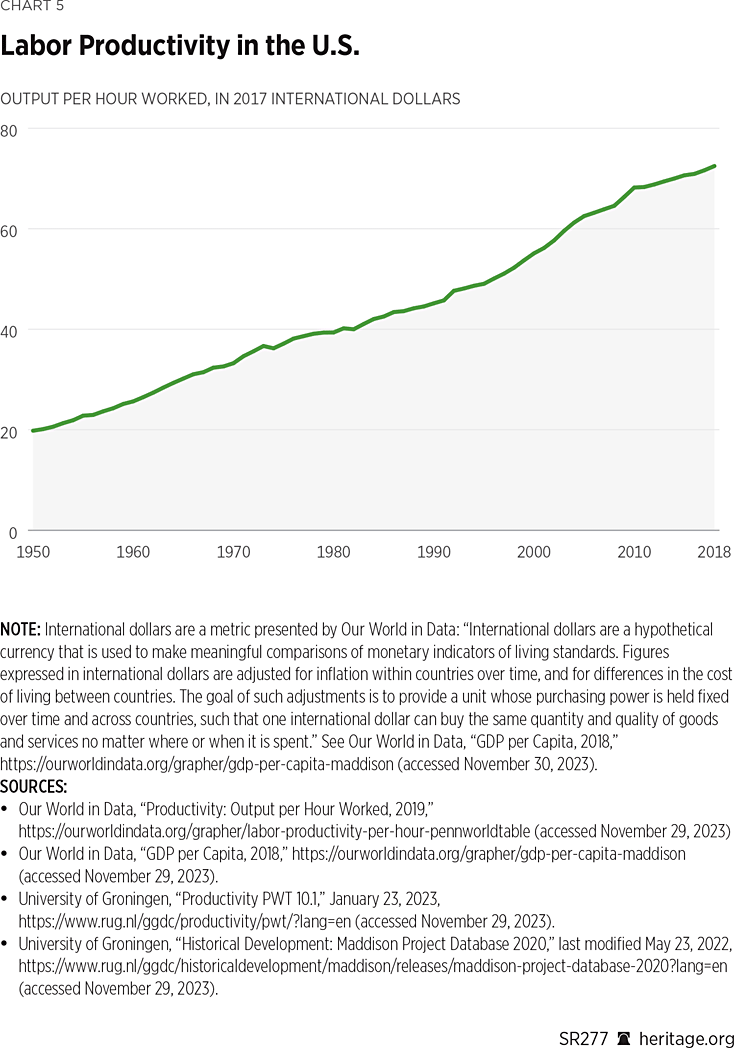
As with GDP, productivity rose dramatically, from $19 per hour worked to $70 per hour worked (in international 2017 dollars) between 1935 and 2018. One major reason for these increases is affordable and reliable energy, the basic building block of society. With greater access to affordable energy, firms can produce more goods and services with the same input of capital and labor. The result is greater national productivity and income—which generally means greater personal income.
These benefits manifest themselves across all economic sectors. The health care sector is one such example. From powering hospitals and incubators for premature babies, to enabling private practices to operate, to fueling the research, development, and use of ever-improving medical treatments, increases in access to energy have been the fuel of improvements to worldwide health. Chart 6 depicts global and U.S. life expectancy over time.
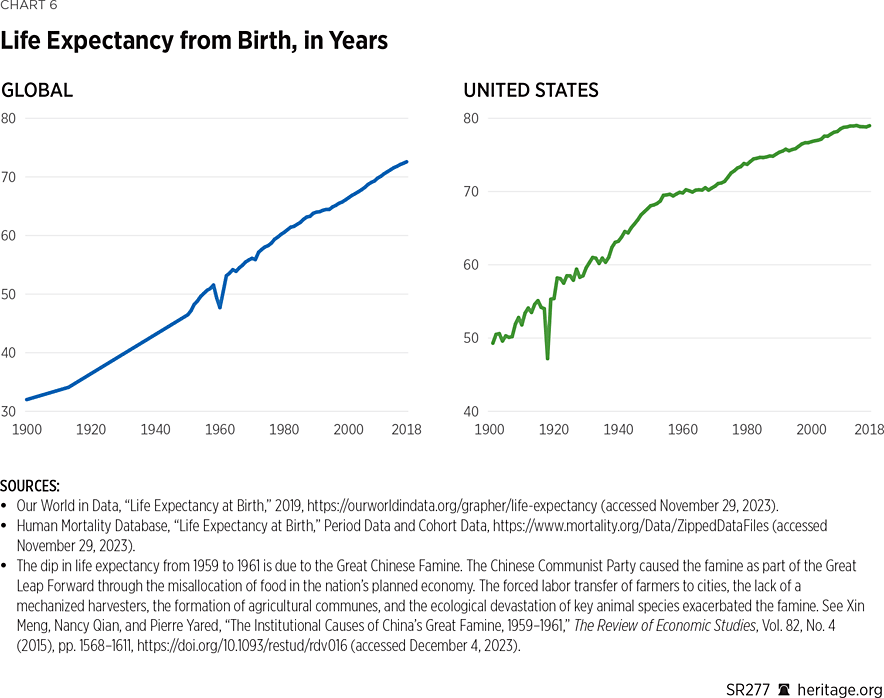
As Chart 6 illustrates, global life expectancy was 32 years in 1900. Over the course of the century, life expectancy has more than doubled to just above 72 years in 2018. The United States follows a similar pattern. Despite a dip during the Spanish flu pandemic between 1918 and 1920, life expectancy has increased from 49 years during the early 1900s to slightly under 79 years in 2018. Energy has been central to the provision of electricity and running water, as well as to medical innovations that have underpinned increases in longevity over this time period.
These improvements have also manifested themselves in reduced child mortality rates, as is evident in Chart 7.
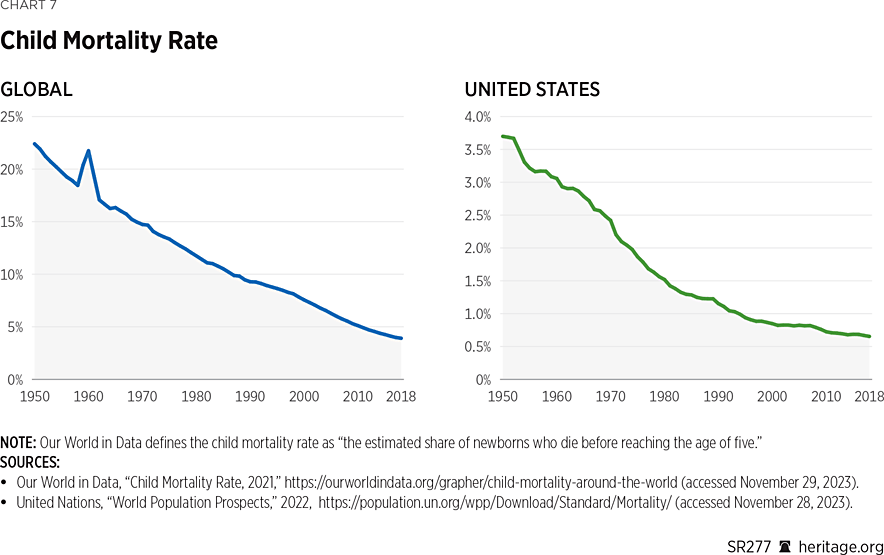
As Chart 7 illustrates, child mortality rates have declined in the United States from 3.70 percent in 1950 to 0.65 percent in 2018. As is also evident in Chart 7, these rates have dropped globally as well. A key driver of these reductions has been medical innovations that enable the prevention and treatment of infections that still kill countless children around the globe.REF
Yet another sector of the global economy that has benefitted from access to affordable and reliable energy is the agricultural sector. In particular, innovations in farm equipment, such as mechanized tractors that harvest food, disperse fertilizer, and plant cover crops, have fostered greater agricultural productivity over the course of the 20th and 21st centuries, both globally and domestically. Chart 8 provides visual representations of these increases in two key agricultural products—corn and wheat—from 1960 through 2018.
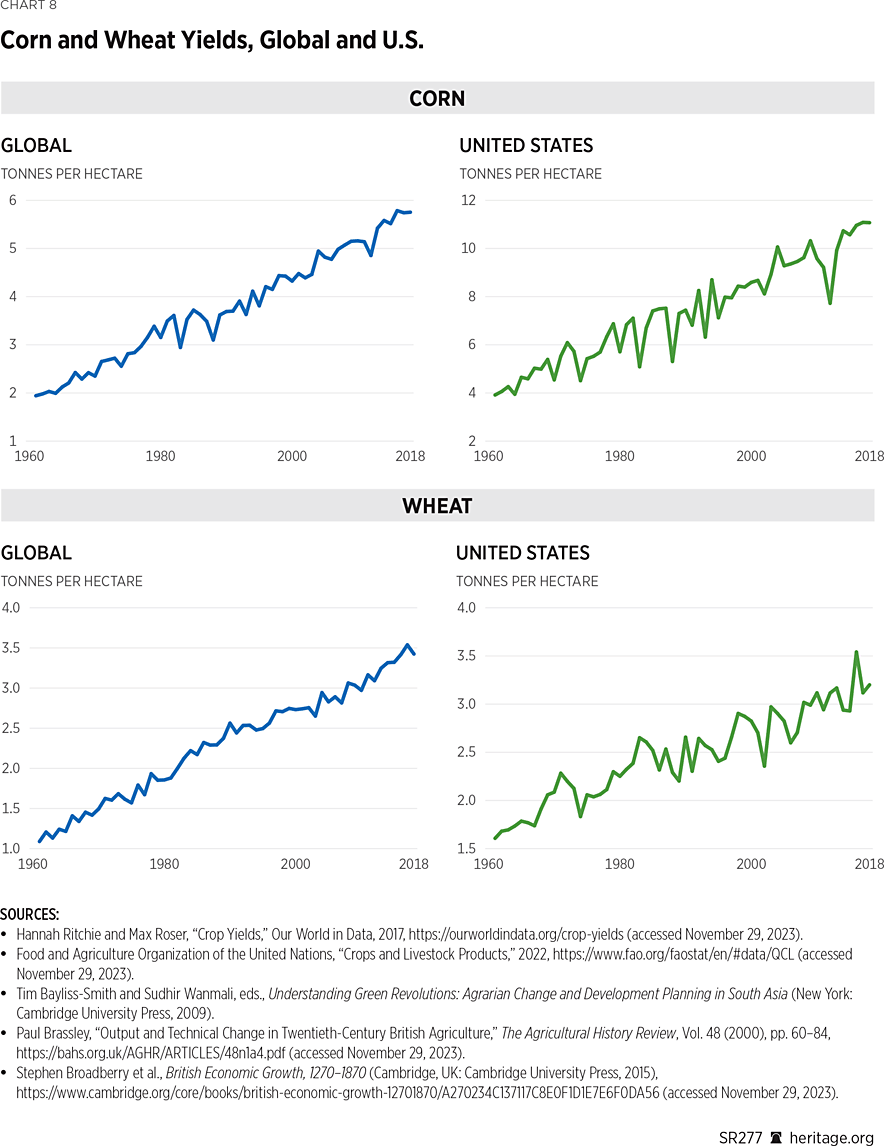
As Chart 8 shows, agricultural yields for wheat and corn have increased from 1960 to 2018 both in the United States and across the world. Comparatively, in terms of corn, the United States performs better than most areas of the world; in 2018 it produced 10 tonnes per hectare compared to an average of slightly less than 6 tonnes per hectare worldwide. Greater access to energy has allowed for improvements to agricultural technology including advanced machinery, such as diesel-powered tractors and lawnmowers, and GPS technology that enables precision farming, remote-sensing technology, irrigation systems, and data management technologies.REF
A Cross-Country Analysis
Although global energy consumption increased significantly over the past century (as shown in Chart 3), a significant amount of heterogeneity in energy usage exists across countries. Consequently, countries also differ in terms of many of the factors associated with energy consumption. For example, Charts 9, 10, and 11 depict the relationship across countries throughout the world in terms of per capita energy consumption alongside per capita GDP, household consumption, and poverty levels in 2018.
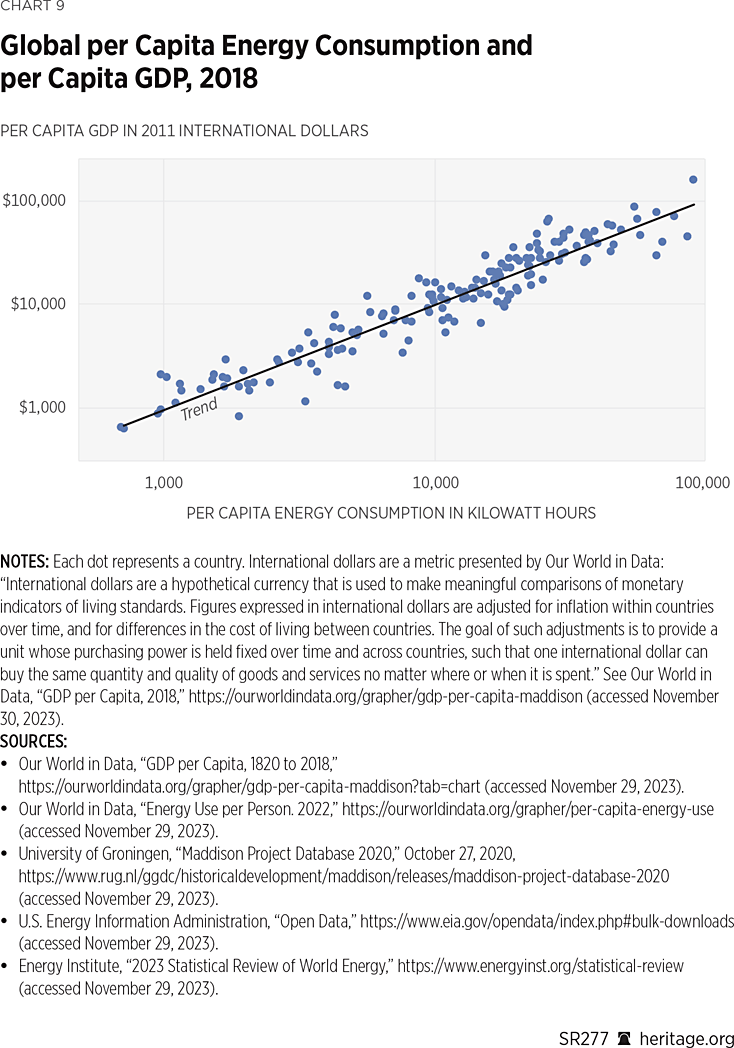
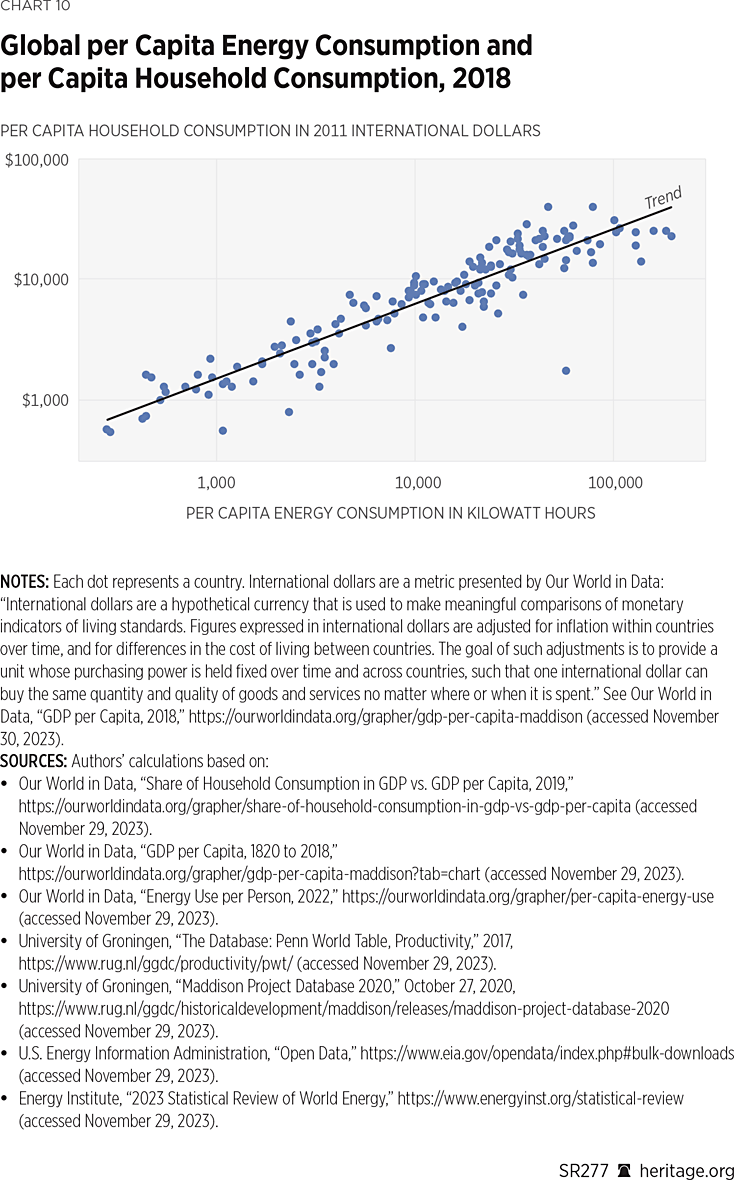
The axes in Charts 9 and 10 are plotted on logarithmic scales because the energy consumption and GDP grow at exponential rates. That is, regardless of the unit being examined, from a logarithmic perspective, an increase from 1,000 to 10,000 is proportionally the same jump as from 10,000 to 100,000. As Charts 9 and 10 illustrate, a strong positive relationship exists between per capita energy consumption and per capita GDP, as well as between per capita energy consumption and per capita household consumption. Countries that use around 500 kilowatt hours (kWh) per capita tend to have subsistence-level production of around $1,000 per year. Countries that use around 100,000 kWh per capita have incomes that allow the purchase of everyday modern luxuries. Consequently, no country has low energy use and high incomes; and no country has high energy use and low incomes.
For example, Lesotho, Djibouti, and Zimbabwe each consumed less than 4,000 kWh of energy on a per capita basis in 2018. That year, they each had an average of less than $4,000 in per capita income and consumed less than $3,000 (in international 2011 dollars). On the other hand, Norway, the United States, and Iceland each consumed more than 80,000 kWh of energy (per capita) and each had more than $40,000 in per capita GDP and more than $20,000 in consumption (in international 2011 dollars).
As a result of the increases in wealth due to greater access to energy, poverty rates decline. (See Chart 11.)
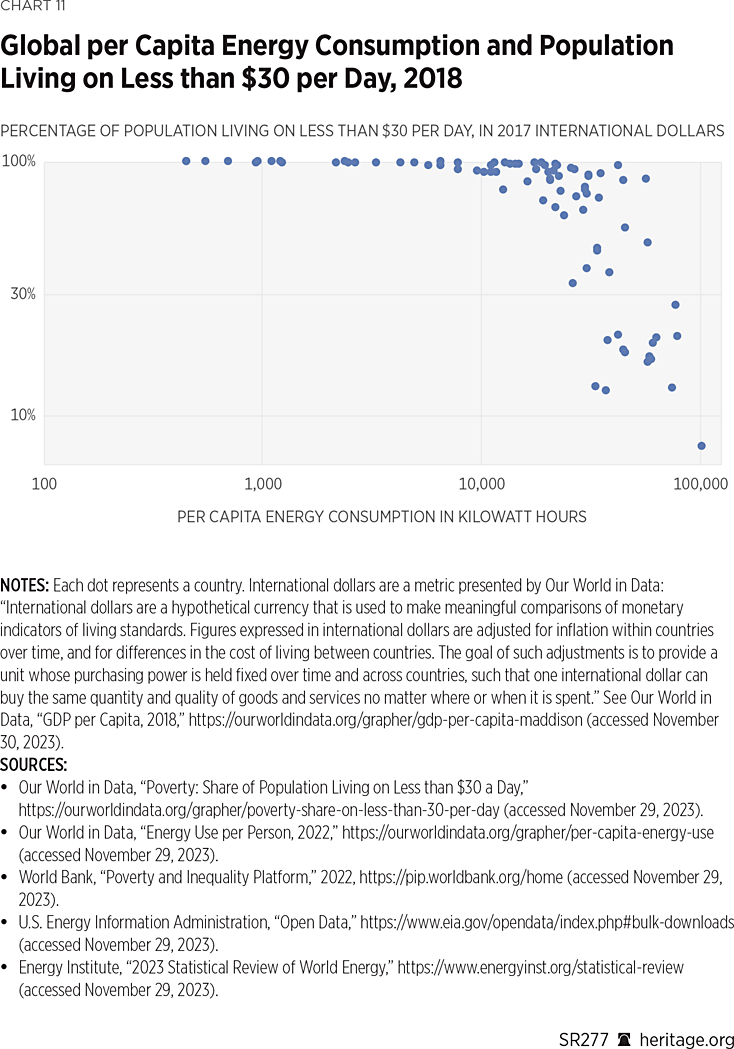
Chart 11 shows a strong negative relationship between per capita energy consumption and the percentage of the country’s population living on less than $30 per day. This percentage declines when per capita energy consumption exceeds 10,000 kWh per capita, falling toward zero when approaching 100,000 per kWh in per capita energy consumption.
Agriculture. Better technologies, including tractors, remote sensing, and GPS technology—all energy-dependent—enable better crop production. Countries that are able to consume more energy are more capable of reaping these benefits than countries that do not have such access. Chart 12 shows this direct positive relationship for two selected types of crops—corn and wheat.
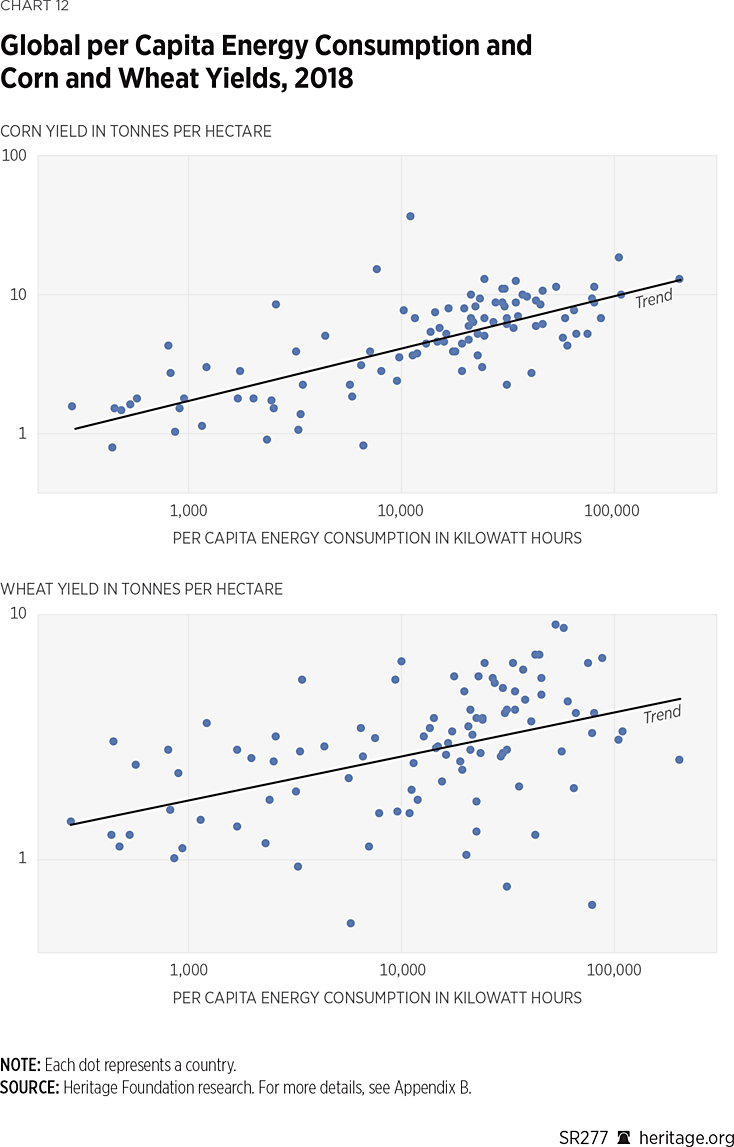
As Chart 12 illustrates, there is a direct and positive relationship between corn and wheat production. Countries that consume low amounts of energy suffer from poor corn and wheat yields. For example, in 2018, Burundi, Niger, and Rwanda consumed between 200 kWh and 500 kWh of energy on a per capita basis and were not able to produce more than 2 tonnes of corn and 3 tonnes of wheat per hectare, largely due to less automated practices. On the other hand, New Zealand, Netherlands, and Denmark each consumed 30,000 kWh of energy on a per capita basis and produced more than 5 tonnes of corn and 6 tonnes of wheat per hectare. Not only is this energy tied to mechanized harvesting but also to the application of fertilizers and the automated planting of cover crops to retain soil health.
Health Care. From the perspective of public health, access to energy is also crucial for survival. Affordable and reliable energy underpins medical training for doctors as well as the tools that they use treating patients. Chart 13 shows the relationship around the world between per capita energy consumption and the number of doctors available per 1,000 people, life expectancy, and child mortality rates for 2018, as well as maternal mortality rates for 2017.REF
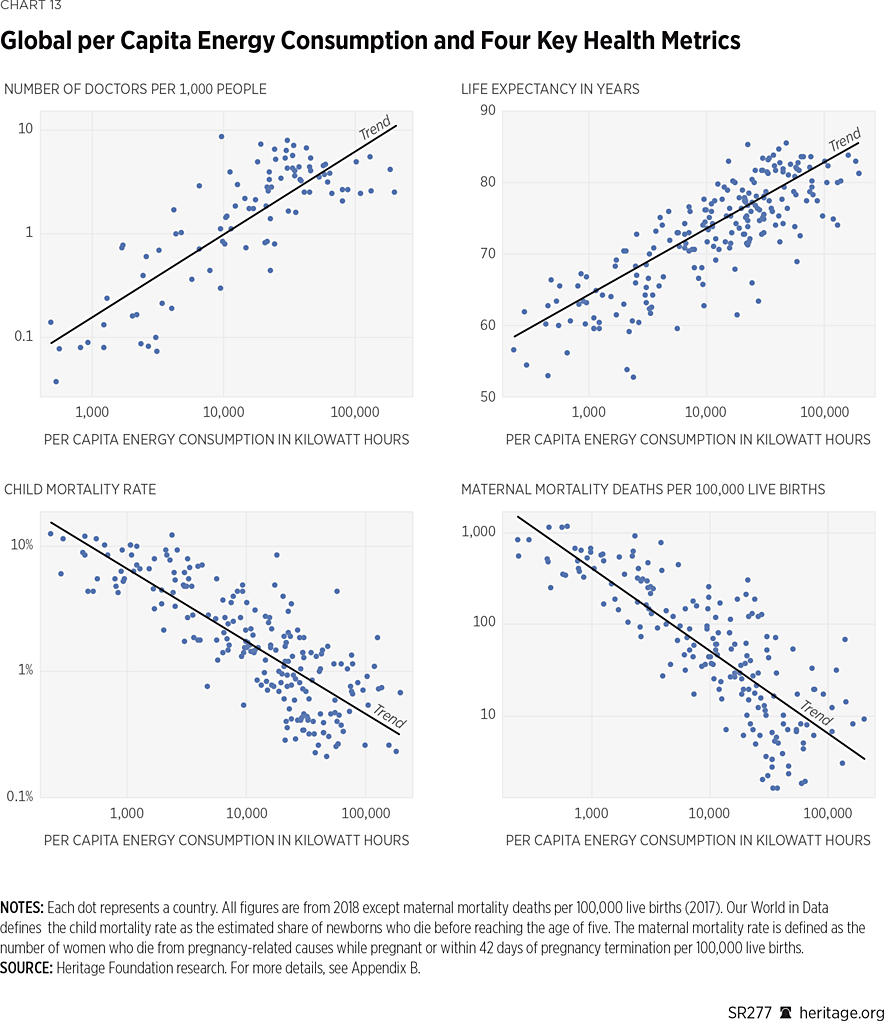
Chart 13 shows significant increases in per capita doctor availability and life expectancy alongside dramatic drops in child and maternal mortality with respect to per capita energy consumption. Malawi, Sierra Leone, and Rwanda each consumed less than 900 kWh of energy on a per capita basis and had less than one doctor per 1,000 people, life expectancies less than 67 years of age, child mortality rates in excess of 4,000 per 100,000, and maternal mortality rates exceeding 200 per 100,000 live births. On the other hand, Japan, Italy, and Greece each consume more than 30,000 kWh of energy and all have more than 2.4 doctors per 1,000 people, life expectancies exceeding 80 years of age, child mortality rates less than 500 per 100,000, and maternal mortality rates less than 12 per 100,000 live births.
Air and Water Quality. From a public health perspective, clean air and clean water are fundamentally important for survival. Greater access to energy results in a more diverse portfolio of sources, from which countries have cleaner sources to choose. In many developing countries, the main source of energy for cooking and heating is biomass, such as wood and crop residues, which increases air pollution.REF Additionally, access to more energy helps to enable the creation, and ultimate adoption, of cleaner technologies from which to produce energy itself. Moreover, access to reliable and affordable energy allows the creation of better tools for air quality management, such as criteria pollutant scrubbers and electrostatic precipitators.
Access to abundant energy is integral for garnering and maintaining clean water. Most notably, access to reliable energy is necessary for pumping, treating, purifying, and distributing clean water. Chart 14 depicts the relationship between per capita energy consumption and deaths due to air pollution and unsafe drinking water.
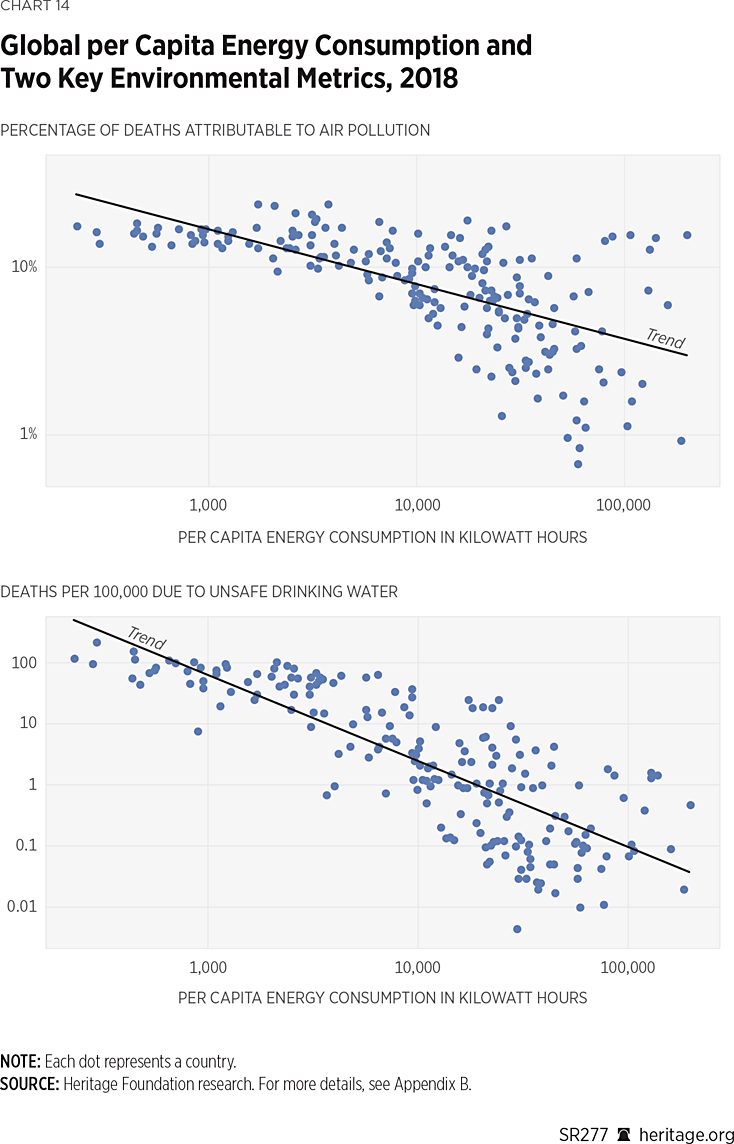
Chart 14 illustrates a substantial drop in mortality rates due to both air pollution and unsafe drinking water, especially once a per capita energy consumption threshold of 20,000 kWh per capita is achieved. Somalia and Madagascar, for instance, have some of the lowest per capita energy consumption rates (each consuming less than 600 kWh per capita) and have the highest mortality rate due to air pollution and unsafe drinking water (each exceeding 15,000 deaths and 40 deaths per 100,000, respectively). On the other hand, Finland, Sweden, and Iceland, have some of the highest per capita energy use rates (each exceeding 60,000 kWh per capita) and have mortality rates due to air pollution rates less than 1,000 per 100,000 and mortality rates due to unsafe drinking water of less than 0.1 per 100,000.
Conclusion
Energy has been indispensable to human advancement. Three technological developments—the steam engine, electricity, and the internal combustion engine—have allowed for the easy transportation of power. Steam engines and turbines are hooked to electromagnets, which generate electricity, one of the currencies of the energy world. Largely, these turbines are powered by hydrocarbons, which are also useful for operating internal combustion engines. In just two centuries, these machines have completely revolutionized human life to allow for unparalleled human advancement and access to material abundance. No matter how this energy is stored, captured, and used, it is clear that the ever-increasing use of energy is needed for both industrialized and industrializing societies to continue advancing.
This Special Report has shown that impoverished countries that only use around 500 kWh of energy per capita often have subsistence-level production and incomes of around $1,000 per year. When energy consumption per capita eclipses 10,000 kWh per capita, there is a drastic decline in poverty, with a virtual eradication around 100,000 kWh per capita. This relationship between economic development and energy use is so strong that there is not a single nation with a high per capita income and low per capita energy usage. Conversely, there is not a single country with high energy use per capita and low per capita income. Higher energy use allows for higher productivity, increased agricultural yields, and higher household consumption, which eliminates the drudgery of subsistence farming. Either these farmers now have access to innovative farming technologies and techniques, or they have the economic mobility to learn other skills and contribute in other ways to their society.
As evident by the numerous examples of medical technology improving with energy access, high-energy-use nations have access to more doctors and safer drinking water, which results in lower maternal and child mortality. Additionally, the rising level of wealth allows for activities such as investing capital in pollution-mitigation measures. If low-energy-use countries are prevented from accessing affordable and reliable energy resources to improve their economies, their progress will stall and may cause residents to search abroad for other opportunities.
Consequently, public policy researchers should inform the public as well as international institutions about the necessity of expanding energy access. Depriving people of any society of reliable and affordable energy denies them access to clean water, adequate medical care, affordable transportation, and economic opportunities, which will limit any human advancement, especially in the most vulnerable countries. Policymakers in all nations should encourage these technologies that are common in high-energy-use nations to allow energy use to flourish. This Special Report has shown that human progress requires access to energy, whether harnessed via steam engine, internal combustion engine, or electricity. Therefore, public policy in the U.S. and every country should advance domestic and worldwide access to affordable and reliable energy so that all humans can enjoy its benefits.
Kevin D. Dayaratna, PhD, is Chief Statistician, Data Scientist, and Senior Research Fellow in the Center for Data Analysis at The Heritage Foundation. Diana Furchtgott-Roth is Director of the Center for Energy, Climate, and Environment at The Heritage Foundation. Miles Pollard is Policy Analyst in the Center for Energy, Climate, and Environment. Richard Stern is Director of the Grover M. Hermann Center for the Federal Budget at The Heritage Foundation. The authors thank Research Assistant for Domestic Policy Andrew Weiss for his valuable research assistance.
This piece is a part of The Heritage Foundation’s Wealth and Innovation project which stands to defend and promote the freedom to innovate, create and use wealth. These are essential to the delicate process by which innovators and entrepreneurs work to build a prosperous and purposeful society.
Appendix A: List of Charts
- Chart 1: Share of U.S. Households Using Specific Technologies
- Chart 2: U.S. Energy Consumption
- Chart 3: Global Energy Consumption
- Chart 4: GDP Per Capita, Global and U.S.
- Chart 5: Labor Productivity in the U.S.
- Chart 6: Life Expectancy from Birth, in Years
- Chart 7: Child Mortality Rate
- Chart 8: Corn and Wheat Yields, Global and U.S.
- Chart 9: Global Per Capita Energy Consumption and Per Capita GDP, 2018
- Chart 10: Global Per Capita Energy Consumption and Per Capita Household Consumption, 2018
- Chart 11: Global Per Capita Energy Consumption and Population Living on Less Than $30 Per Day, 2018
- Chart 12: Global Per Capita Energy Consumption and Corn and Wheat Yields, 2018
- Chart 13: Global Per Capita Energy Consumption and Four Key Health Metrics
- Chart 14: Global Per Capita Energy Consumption and Two Key Environmental Metrics, 2018
Appendix B: Additional Sources
Chart 12: Global Per Capita Energy Consumption and Corn and Wheat Yields, 2018
- Our World in Data, “Energy Use per Person, 2022,” https://ourworldindata.org/grapher/per-capita-energy-use (accessed November 29, 2023).
- Hannah Ritchie and Max Roser, “Crop Yields,” Our World in Data, 2017, https://ourworldindata.org/crop-yields (accessed November 29, 2023).
- Food and Agriculture Organization of the United Nations, “Crops and Livestock Products,” 2022, https://www.fao.org/faostat/en/#data/QCL (accessed November 29, 2023).
- Tim Bayliss-Smith and Sudhir Wanmali, eds., Understanding Green Revolutions: Agrarian Change and Development Planning in South Asia (New York: Cambridge University Press).
- Paul Brassley, “Output and Technical Change in Twentieth-Century British Agriculture,” The Agricultural History Review, Vol. 48 (2000), pp. 60–84, https://bahs.org.uk/AGHR/ARTICLES/48n1a4.pdf (accessed November 29, 2023).
- Stephen Broadberry, British Economic Growth, 1270–1870 (Cambridge, UK: Cambridge University Press, 2015), https://www.cambridge.org/core/books/british-economic-growth-12701870/A270234C137117C8E0F1D1E7E6F0DA56 (accessed November 29, 2023).
- U.S. Energy Information Administration, “Open Data,” https://www.eia.gov/opendata/index.php#bulk-downloads (accessed November 29, 2023).
- Energy Institute, “2023 Statistical Review of World Energy,” https://www.energyinst.org/statistical-review (accessed November 29, 2023).
Chart 13: Global Per Capita Energy Consumption and Four Key Health Metrics
- Our World in Data, “Medical Doctors per 1,000 People, 2019,” https://ourworldindata.org/grapher/physicians-per-1000-people (accessed November 29, 2023).
- Our World in Data, “Energy Use per Person, 2022,” https://ourworldindata.org/grapher/per-capita-energy-use (accessed November 29, 2023).
- Our World in Data, “Life Expectancy at Birth 2021,” https://ourworldindata.org/grapher/life-expectancy?tab=map (accessed November 29, 2023).
- Our World in Data, “Child Mortality Rate, 2021,” https://ourworldindata.org/grapher/child-mortality-around-the-world (accessed November 29, 2023).
- Our World in Data, “Maternal Mortality Ratio, 2020,” https://ourworldindata.org/grapher/maternal-mortality (accessed November 29, 2023).
- World Bank, “Data Catalog: World Development Indicators,” https://datacatalog.worldbank.org/search/dataset/0037712/World-Development-Indicators (accessed November 29, 2023).
- World Bank, “Maternal Mortality Ratio (Modeled Estimate, per 100,000 Live Births),” 2017, https://data.worldbank.org/indicator/SH.STA.MMRT (accessed November 29, 2023).
- U.S. Energy Information Administration, “Open Data,” https://www.eia.gov/opendata/index.php#bulk-downloads (accessed November 28, 2023).
- Energy Institute, “2023 Statistical Review of World Energy,” https://www.energyinst.org/statistical-review (accessed November 29, 2023).
- Human Mortality Database, “Life Expectancy at Birth,” Period Data and Cohort Data, https://www.mortality.org/Data/ZippedDataFiles (accessed November 29, 2023).
- United Nations, “World Population Prospects 2022,” https://population.un.org/wpp/Download/Standard/MostUsed/ (accessed November 29, 2023).
- OECD.Stat, “Health Status: Maternal and Infant Mortality,” https://stats.oecd.org/index.aspx?queryid=30116 (accessed November 29, 2023).
Chart 14: Global Per Capita Energy Consumption and Two Key Environmental Metrics, 2018
- Our World in Data, “Share of Deaths Attributed to Air Pollution, 2019” https://ourworldindata.org/grapher/share-deaths-air-pollution (accessed November 29, 2023).
- Our World in Data, “Death Rates from Unsafe Water Sources, 2019,” https://ourworldindata.org/grapher/death-rates-unsafe-water (accessed November 29, 2023).
- Our World in Data, “Energy Use per Person, 2022,” https://ourworldindata.org/grapher/per-capita-energy-use (accessed November 29, 2023).
- IHME/GHDx, “Global Burden of Disease Study 2019 (GBD 2019) Data Resources,” https://ghdx.healthdata.org/gbd-2019 (accessed November 29, 2023).
- U.S. Energy Information Administration, “Open Data,” https://www.eia.gov/opendata/index.php#bulk-downloads (accessed November 29, 2023).
- Energy Institute, “2023 Statistical Review of World Energy,” https://www.energyinst.org/statistical-review (accessed November 29, 2023).






